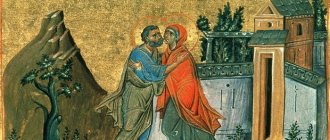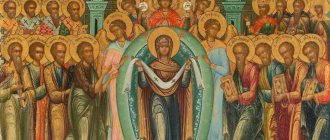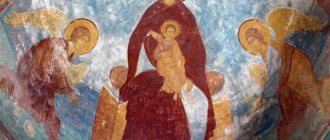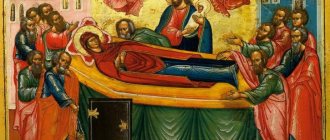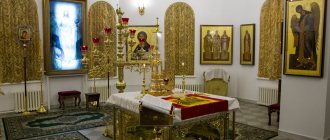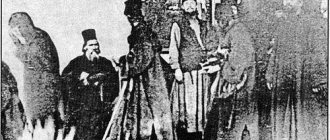| Meeting of the Most Holy Theotokos and Ever-Virgin Mary and Righteous Elizabeth. Fresco (1191) in the Church of St. George, Kurbinovo, Macedonia |
Meeting (meeting) of the Most Holy Theotokos and holy righteous Elizabeth, mother of St. John the Baptist
, celebration of the Jerusalem Hornensky convent, also called
the “second Annunciation”
or
“Kissing”
Celebrated on March 30 [1]
Having announced to the Blessed Virgin Mary the good news from above that She had been chosen by God to give birth to the Savior (Luke 1:28-33), Archangel Gabriel revealed to Her the secret of the Incarnation: “The Holy Spirit will come upon You, and the power of the Most High will overshadow You; therefore the Holy One who is to be born will be called the Son of God. Here is Elizabeth, your relative, who is called barren, and she conceived a son in her old age, and she is already in her sixth month. For with God no word will fail.”
(Luke 1:35-37).
The Holy Evangelist Luke further narrates that the Most Holy Theotokos, having given thanks to the Archangel Gabriel ( “Behold, the Servant of the Lord; let it be done to Me according to your word”
), hastened
“to the mountainous country
[hence the name of the area “Mountain”]
, to the city of Judah”
[2] .
Here the Blessed Virgin Mary met with the righteous Elizabeth, the sister of her mother (Holy Righteous Anna), who was her niece. “And she entered the house
of [the priest]
Zechariah, and greeted
[his wife]
Elizabeth.
When Elizabeth heard Mary’s greeting, the baby leaped in her womb [the future holy prophet and Baptist of the Lord John the Baptist]
, and Elizabeth was filled with the Holy Spirit, and exclaimed with a loud voice and said: Blessed are You among women and blessed is the Fruit of Your womb!
And where does it come from for me that the Mother of My Lord came to me? For when the voice of Your greeting reached my ears, the baby leaped joyfully in my womb. And blessed is she who believed, for what was spoken to her by the Lord will be fulfilled” (Luke 1:40-45).
Next, the evangelist cites a song of praise to the Blessed Virgin Mary: “My soul magnifies the Lord...”
(Luke 1, 46-55; “Most Honest” in the Orthodox Charter, which is sung at Matins according to the 9th song of the canon).
The Most Holy Virgin Mary stayed in the house of the priest Zechariah together with the righteous Elizabeth for three months, after which, when the time came for Elizabeth to give birth, she returned to the city of Nazareth, to Her home.
| Icon of the meeting of the Blessed Virgin Mary and the holy righteous Elizabeth |
In 1871, the head of the Russian Spiritual Mission in Jerusalem, Archimandrite Antonin (Kapustin), acquired a plot of land in Ain-Karim, where, according to legend, stood the house of the righteous Elizabeth, who was visited by the Most Holy Theotokos.
With the blessing of the Holy Synod of the Russian Orthodox Church, the Gornenskaya monastery for women was founded here, which from then until now has been under the jurisdiction of the Russian Spiritual Mission. The rules regulating the life of the monastery were approved by the Holy Synod in 1898. In 1883, Archimandrite Antonin petitioned the Holy Synod to establish a special holiday in memory of the visit of the Blessed Virgin Mary to Her righteous relative Elizabeth and Her stay here for three months. By the decree of the Synod of August 5, 1883, this celebration was established to take place on March 30, if this day did not fall during the period from Lazarus Saturday to Easter; otherwise the celebration is moved to Friday of Holy Week. Archimandrite Antonin at the same time composed for the service of this celebration special stichera on the Lord, calling and verse, as well as a troparion with kontakion. The canon for Matins on this day and the stichera for Praise are set for the Annunciation. According to the decree of the Holy Synod, all services on the “Gornensky Feast” must be performed according to the Annunciation chapter of the Typikon, including the liturgy of St. John Chrysostom [3].
In the Russian women's Gornensky monastery, a pious custom is still preserved: for the holiday, an icon of the Annunciation from the Trinity Cathedral of the Russian Mission is brought to the source of the Mother of God in Ain-Karem. The icon is awaited by the sisters of the Gornensky monastery and pilgrims with bouquets of flowers in their hands. At the source, an excerpt from the Gospel of Luke is read, telling about a memorable event. After the prayer service, under the ringing of bells, a procession of the cross takes place into the monastery through the eastern gates to the Kazan Church. The abbess and the sisters take turns carrying the icon. A carpet of flowers is laid out in front of the temple for the holiday. The icon is placed on a special elevated place with a cover in the form of a blue mantle and the abbot's staff. For the duration of the image’s stay in the monastery, the Mother of God is revered here as the abbess, while the abbess of the monastery herself no longer stands in the abbot’s place, but is located next to it. The icon of the Annunciation, in memory of the three-month stay of the Mother of God as a guest of the righteous Zechariah and Elizabeth, remains in the monastery for three months, until the day of the Nativity of John the Baptist, after which the image returns to the Trinity Cathedral [4].
History of the “Sweet Kiss” icon
When the iconoclast emperor Theophilos took the Byzantine throne, he ordered the destruction of all icons. The wife of his close associate Simeon, Victoria, revered the icon and hid it in her chambers. When her husband demanded that the icon be burned, she, having prayed, released it into the freedom of the sea waves.
Along the waves, this icon sailed to Athos, to the Philotheus monastery, and a procession of the cross is still held on Easter Monday to the place where it was found.
For more than a thousand years of stay in the monastery, the icon of “Glycophilus” showed many miracles.
Thus, in one married couple from Pryor, the wife suffered from infertility, but when the husband offered a passionate prayer before the icon of the Mother of God “Sweet Kiss,” the oil from the lamp burning in front of the icon helped: he anointed his wife and himself with the oil, and at the same time year their son was born.
Another miracle was the return of the kidnapped person and the repentance of the criminal. This happened in 1801. The icon of “Glycophilus” was decorated with gold coins hung from the frame. One pilgrim was flattered by them and kidnapped them, after which he boarded a ship and tried to escape. However, although the wind was blowing favorably, the ship stopped close to the shore and did not move further. When they discovered the loss, they began to search everywhere, including sending a boat to the ship. The kidnapper, seeing the miracle performed, repented and returned the stolen goods, and the ship continued sailing.
Another miracle happened already in the 20th century, when Greece was under German occupation. The monastery had almost run out of wheat, and it was decided not to accept any more pilgrims. Only the elder Father Savva opposed this decision and persuaded the brethren to abandon it. When there was just a little flour left, he again persuaded them to bake bread from the leftovers and distribute them not only to the monks, but also to the laity, trusting in the mercy of the Most Pure Virgin. When this was done, a ship carrying wheat moored to the pier, and the captain offered to exchange part of it for firewood. So the Mother of God again took care of her children.
The “Sweet Kiss” icon is of particular significance for those who pray to protect children from illnesses and dangers, to introduce them to the true faith, to respect their parents and strengthen their spirit when life’s problems arise.
Celebration is on Easter Monday.
Wood carved figure of Elisabeth of Thuringia
Elizabeth of Thuringia (Hungary) is a medieval Catholic saint, after whom the Grand Duchess was named at birth. Her husband went on a crusade, where he fell ill with the plague and never returned home. Then she parted with all her jewelry and built a hospital for lepers and the disabled in the German city of Marburg. From childhood, Princess Elizabeth knew the life story of the Catholic saint after whom she was named, and amazingly repeated her fate. Elizabeth of Thuringia lived on earth for 24 years, and Elizaveta Fedorovna lived for 54.
#0d4210
Icon “Kissing the Mother of God and Righteous Elizabeth”
Another name for this icon is “The Meeting of the Most Holy Theotokos and the Holy Righteous Elizabeth” (Meeting means meeting). According to the Gospel tradition, after the Annunciation - the appearance of the Archangel Gabriel, the Virgin Mary hurried to Elizabeth, her mother's sister. Childless Elizabeth and her husband priest Zachary were already in old age, but the Lord gave them a son, the future John the Baptist, with whom Elizabeth was pregnant at that moment.
The ancient icon painter, who painted the icon “The Meeting of Mary and Elizabeth,” depicted these holy women with Babies in their wombs; the later icon “Kissing the Mother of God” simply depicts their embrace. Upon meeting the Virgin Mary, Elizabeth was filled with the Holy Spirit and glorified Mary as the Mother of the Savior.
They pray to this icon for the protection of the Mother of God and for the gift of children, healthy and strong.
Celebration - March 30/April 12.
Official decree of Alexander III on Elizabeth Feodorovna's adoption of Orthodoxy
Before her marriage, Elizaveta Fedorovna was a Protestant. The law allowed her to marry a representative of a different religion and not change hers, since Grand Duke Sergei Alexandrovich was not an emperor. However, after a trip to Jerusalem to consecrate the Church of St. Mary Magdalene, which was built with joint funds by princes Sergei Alexandrovich, Pavel Alexandrovich and their sister Maria, Elizabeth Feodorovna’s views gradually began to change. There are memories that tell: after one of the services in Jerusalem, an unknown person approached Sergei Alexandrovich and said: “Well, we can congratulate you, she is already ours.” Three years after this trip to the Holy Land, she converted to Orthodoxy.
Prayer to the Most Holy Theotokos before Her icon “Sweet Kiss” or “Glycophilus”
Accept, O All-merciful, Most Pure Lady, Lady Theotokos, these honorable gifts, the only ones applied to You, from us, Your unworthy servants, chosen from all generations, manifested above all creatures of heaven and earth. Because for Your sake the Lord of hosts was with us, and through You we knew the Son of God, and became worthy of His Holy Body and His Most Pure Blood. Blessed are you, too, in the birth of births, God-blessed One, the brightest of the Cherubim and the most honest of the Seraphim. And now, All-Singing Most Holy Theotokos, do not cease praying for us, Thy unworthy servants, that we may be delivered from every evil advice and from every situation, and that we may be preserved unharmed from every poisonous pretext of the devil. But even to the end, through Your prayers, keep us uncondemned, as if through Your intercession and help we are saved, we send glory, praise, thanksgiving and worship for everything in the Trinity to the One God and the Creator of all, now and ever and unto the ages of ages. Amen.
Antique piano
Elizaveta Fedorovna gave concerts in the house of the Governor-General, played Chopin, Russian classics, and loved to sing Russian romances. The piano belonged to her, but it stood in the basement for quite a long time and did not go upstairs, so one could only guess about its ownership by Elizabeth. Subsequently, the signature “Ella” was found scrawled on it, which looked exactly the same as all the signatures of the Grand Duchess.
Elizaveta Feodorovna's glove
The Grand Duchess dropped this glove during her arrest. The Bolsheviks came for her on Easter week, on the day of the Iveron Icon of the Mother of God. She was in a hurry, because she only had about half an hour to get ready, and she needed to resolve all the issues and help her sisters for the last time in her life.
A separate room in the house-museum is dedicated to Archimandrite Sergius, one of the most important figures in the spiritual life of the Marfo-Mariinsky monastery.
Cross with precious stones
Father Sergius was famous throughout Russia and enjoyed special favor from the royal family. Nicholas II offered Sergius to become their confessor, but he refused because of his attitude towards Rasputin. Despite this, the emperor did not change his attitude towards him and even awarded him a cross with precious stones. In the last years of his life, after going through three exiles, he became Archimandrite Sergius, and his childless wife took monasticism with the name Elizabeth. When they buried his wife, they accidentally touched and lifted the lid of his coffin, after which it was discovered that the relics remained incorrupt.
The Martha and Mary Convent invites everyone on October 11, 2018 to celebrate the 100th anniversary of the martyrdom of the Holy Martyr Grand Duchess Elizabeth Feodorovna.
Divine Liturgy will begin in the Intercession Church of the Monastery , at which His Holiness Patriarch Kirill of Moscow and All Russia is expected.
At 13:00 - consecration of the temple-chapel in honor of the holy martyr Grand Duchess Elizabeth Feodorovna.
All day at the festival you will be able to:
— take a tour of the Grand Duchess’s house-museum;
— purchase literature, postcards and souvenirs dedicated to the life of Elizabeth Romanova;
— take part in a charity fair of author’s works.
We will be glad to meet you at the Martha and Mary Convent of Mercy!
October 11, 2022 Moscow, Bolshaya Ordynka, 34.
